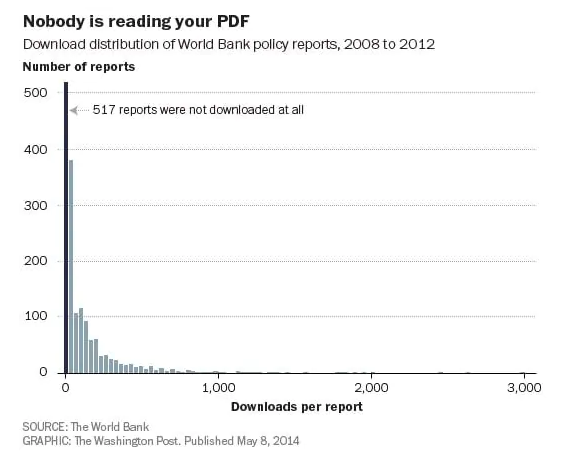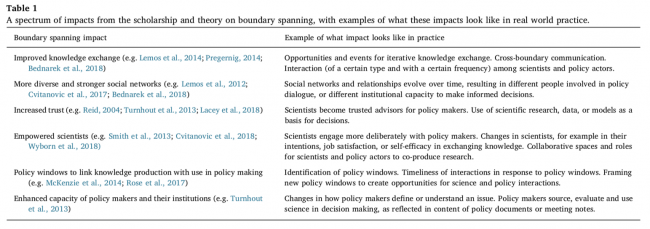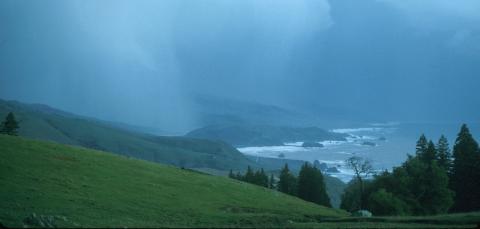Science and scientists have a critical role to play in environmental decisions. Policymakers provide key context to help scientists understand the questions that scientists can answer. But decision-makers will not access the latest science and scientists will not understand the culture in which decision-makers operate without sustained support in spanning the boundary between the two.
This “valley of death” is a well-described phenomenon, most commonly used in reference to the gap between basic research and industrial product development or clinical implementation. However, it is also highly relevant to the gap between science and environmental decision-making (U.S. House of Representatives 1998; National Research Council 2000). The “valley of death” describes the familiar pattern by which research with high relevance to potential solutions never makes it out of an academic journal and never reaches the audience that stands to benefit most from its findings. And while not all policy issues lend themselves to resolution through science, the use of science falls short even when it might be applied to a substantive end (Bogenschneider 2019).
In 2014, the World Bank did a study to take an introspective look at its own reports, most of them which had been developed with the explicit objective of informing public discourse or government policy, unlike most scientific publications. The World Bank asked the simple question: Is anyone reading what we are writing? What they found is that nearly one-third of their PDF reports had never been downloaded—by anyone—not even once. Another 40% of their reports had been downloaded fewer than 100 times. Only 13% had been downloaded more than 250 times in their lifetimes.

The Washington Post.
The Washington Post reporter Christopher Ingraham characterized this finding in the pithy title of his news article about the World Bank study, “The solutions to all our problems may be buried in PDFs that nobody reads.” Tongue-in-cheek aside, ongoing physical, social, and conceptual differences really do persist at the boundary between science and policy communities (Cash et al., 2003; Guston 2001; Guston et al., 2000). The knowledge-decision gap is a real and serious problem, and not one that is easy to fix without significant attention, funded capacity, and skillful intervention.
For more than 20 years, well-known scholars, including Daniel Sarewitz and David Guston at Arizona State University (Sarewitz and Pielke 2007; Guston 2001; Guston 2014) and many others, have identified and characterized the critical role that “boundary spanning” or “knowledge brokering” can play in enhancing the uptake of science in decision-making to advance solutions to complex problems—from sustainability to climate adaptation to nanotechnology. A body of scholarship has emerged that helps describe and identify various support structures—from individuals to programs to organizations—that can help ensure that the knowledge that is produced is actually useful to decision-makers, and accessible at the right time and in the right format (e.g., policy brief versus academic journal article).
Successful boundary spanning brings many benefits to the science-policy discourse. For example, it can counteract the negative impacts of political polarization and push open new “policy windows,” discrete periods of time and attention when there is an increase in the potential uptake of science in decision making. Policy windows can open rapidly. For example, when an extreme weather event causes devastating flooding, a policy window usually opens in the aftermath where science can inform how to make communities more resilient in the future. Boundary spanning can streamline the uptake of new science so that relevant research is “ready to go” when a policy window opens. The table below, reprinted with permission from a recent paper by Posner and Cvitanovic (2019) documents some benefits of boundary spanning identified from both theory and scholarship.

In recent years, a growing community of “boundary-spanners,” the ‘individuals or organizations that specifically and actively facilitate this process of boundary spanning,’ began working together to develop a theory of change that describes what is required to do this kind of work (Bednarek et al., 2018), with a goal of enhancing its profile and the opportunities it presents, and encouraging more systemic investment. Lasting support for effective science-policy boundary spanning requires the collective impact of funders, nongovernmental organizations, along with institutional mechanisms that promote knowledge coproduction and science-policy collaboration. To create this enduring change will require shifts in funding practices for science and dedicated support to build capacity at the science-policy interface.
Universities offer unique opportunities as potential boundary spanning entities, but they often lack the governance structures and institutional incentives to engage effectively with decision-makers. Universities are inherently place-based, residing in a city, county, and state, which offers natural pathways for university research to inform local decision-contexts—from public meetings to legislative briefings. However, with a few exceptions, state and local policymakers rarely tap university science for information in systemic ways, citing barriers such as a mismatch in timing. Policymakers often need answers faster than scientists can produce them. Novel models of university-policy collaboratives are emerging in certain states, driven by the request of governors and state legislators to have ready, university-based research easily accessible. Notable examples are The Collaborative in Rhode Island, NC Policy Collaboratory in North Carolina, and the Wisconsin Family Impact Seminars in Wisconsin. Though different in approach, these examples offer potential templates for systemically linking university researchers and state policymakers. NCSE is looking critically at these models and exploring opportunities to catalyze science-policy collaboratives in other states.
NCSE draws together networks of universities and decision-makers, and is uniquely positioned to build bridges at the science-policy interface. For nearly 30 years, we have worked in a nonpartisan manner across a network of over 100 universities and community colleges through the deans and directors of environmental programs. In January 2019, NCSE merged with a network of over 180 local governments across the United States, forming NCSE Applied Solutions. NCSE also serves as the Secretariat to the Governors’ Accord for a New Energy Future, a bipartisan effort that connects NCSE directly to state-level government in 17 states, as well as bringing strong connections in the U.S. federal policy environment. At the international level, NCSE acts as a bridge to multilateral processes such as UN Environment and is collaborating directly with science institutions in France and other countries.
These powerful networks within NCSE’s umbrella—universities, local and state governments, multilateral organizations—provide crucial substrate for improving the scientific basis of environmental decision-making. As we build new portfolios of work at the science-policy interface, we are mindful of the evidence that shows the need for thoughtfully structured capacity for active and sustained boundary spanning. The NCSE 2020 Annual Conference on Science in Environmental Decision-Making in January will provide a forum for advancing these key discussions and forming collaborations that further strengthen the boundary spanning work that so effectively reflects the mission of NCSE.
Traversing the “valley of death” between science and environmental decision-making at the scale of NCSE’s whole network of universities is no small undertaking. We are excited to build upon the experiences of scholars and practitioners at the science-policy interface and look forward collaborating with all of you.
Boundary Spanning in Practice: Managing Water in the West with Forecast Informed Reservoir Operations (FIRO)

Forecast Informed Reservoir Operations or FIRO is an example of boundary spanning in practice. This novel management strategy uses data from watershed monitoring and modern weather and water forecasting to help water managers selectively retain or release water from reservoirs in a manner that reflects current and forecasted conditions. FIRO began in 2014, when a large interdisciplinary, interagency group of experts in civil engineering, hydrology, meteorology, biology, economics, and climate from several federal, state, and local agencies and universities came together to investigate how weather forecast information can inform water management decisions. Scientists and managers from the Army Corps of Engineers, Sonoma Water, the Center for Western Weather and Water Extremes at Scripps Institution of Oceanography, the National Oceanic and Atmospheric Administration, the U.S. Geologic Survey, the U.S. Bureau of Reclamation, and the California Department of Water Resources are now working together on decision-making, with a specific focus of understanding how to manage extreme precipitation and flood risk associated with Atmospheric Rivers (AR), “rivers in the sky” that carry most of the water vapor outside of the tropics. In early 2019, the Army Corps of Engineers announced one of the first policy changes to implement FIRO, approving a major deviation at the pilot reservoir Lake Mendocino in the Russian River valley in northern California. This request will allow a maximum of 3.8 billion gallons of additional water, enough to supply approximately 97,000 people for a year, to be stored in Lake Mendocino during the winter rainy season to improve water supply reliability and environmental conditions in the Russian River while continuing to ensure flood management capacity of the reservoir.
References
Bednarek, A.T., Wyborn, C., Cvitanovic, C., et al., 2018. Boundary spanning at the science-policy interface: the practitioners’ perspectives. Sustain. Sci. 13 (4), 1175–1183.
Bogenschneider, K. Corbett, T. J., and E. Parrott, 2019. Realizing the Promise of Research in Policymaking: Theoretical Guidance Grounded in Policymaker Perspectives. Journal of Family Theory & Review 11 (1), 127-147.
Bogenschneider, K., Day, E., & Parrott, E. (2019, May 2). Revisiting Theory on Research Use: Turning to Policymakers for Fresh Insights. American Psychologist.
Cash, D.W., Clark, W.C., Alcock, F., et al., 2003. Knowledge systems for sustainable development. PNAS 100, 8086–8091.
Guston, D.H., 2001. Boundary organizations in environmental policy and science: an introduction. Sci. Technol. Human Values 26, 399–408.
Guston, D.H., 2014. Building the capacity for public engagement with science in the United States. Public Underst. Sci. 23, 53–59.
National Research Council. 2000. From Research to Operations in Weather Satellites and Numerical Weather Prediction: Crossing the Valley of Death. Washington, DC: National Academies Press.
Posner, S. M. and C. Cvitanovic. 2019. Evaluating the impacts of boundary-spanning activities at the interface of environmental science and policy: A review of progress and future research Needs. Environ. Sci. Policy 92, 141-151.
Sarewitz, D., Pielke, R.A., 2007. The neglected heart of science policy: reconciling supply of and demand for science. Environ. Sci. Policy 10, 5–16.
Smith, B., et al. 2013. COMPASS: Navigating the Rules of Scientific Engagement. PLOS Biology. https://doi.org/10.1371/journal.pbio.1001552
U.S. House of Representatives, Committee on Science. 105th Congress (Sep. 1998) Unlocking our Future: Toward a new National Science Policy.